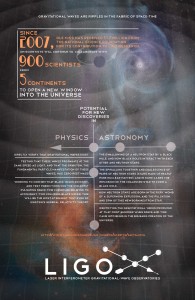OXFORD, Miss. – An international collaboration of scientists, including those at the University of Mississippi, is thrilled with a major equipment upgrade that will greatly aid the search for gravitational waves, black holes and other interstellar phenomena.
The Advanced LIGO Project increases the sensitivity of the Laser Interferometer Gravitational-wave Observatories instruments by a factor of 10 and provides a 1,000-fold increase in the number of astrophysical candidates for gravitational wave signals. The system was officially dedicated May 19 in a ceremony at the LIGO Hanford facility in Richland, Washington.
“We’ve spent the past seven years putting together the most sensitive gravitational-wave detector ever built,” said David H. Reitze, executive director of the LIGO Project and a scientist at the California Institute of Technology. “Commissioning the detectors has gone extremely well thus far, and we are looking forward to our first science run with Advanced LIGO beginning later in 2015. This is a very exciting time for the field.”
Marco Cavaglia, UM associate professor of physics and astronomy and Ole Miss LIGO Project director, concurred.
“The LIGO Team at UM would like to express heartfelt thanks to all LIGO Lab and LIGO Scientific Collaboration colleagues who have worked so hard to make Advanced LIGO a reality,” Cavaglia said. “The success of LIGO to date is a remarkable accomplishment and a major milestone for our field. The next few years will no doubt be quite exciting.”
For a complete review of LIGO research at Ole Miss, visit http://ligo.phy.olemiss.edu/.
LIGO was designed and is operated by Caltech and MIT, with funding from the National Science Foundation. Advanced LIGO, funded by the NSF with important contributions from the UK Science and Technology Facilities Council, the Max Planck Society of Germany and the Australian Research Council is being brought online, with the first searches for gravitational waves planned for the fall of 2015.
The ceremony featured remarks from speakers, including Caltech president Thomas F. Rosenbaum, the Sonja and William Davidow Presidential Chair and professor of physics; Professor of Physics B. Thomas Soifer, the Kent and Joyce Kresa Leadership Chair of Caltech’s Division of Physics, Mathematics and Astronomy; Kirk Kolenbrander, MIT vice president; and France Córdova, director of the National Science Foundation.
“Advanced LIGO represents a critically important step forward in our continuing effort to understand the extraordinary mysteries of our universe,” says NSF director Córdova. “It gives scientists a highly sophisticated instrument for detecting gravitational waves, which we believe carry with them information about their dynamic origins and about the nature of gravity that cannot be obtained by conventional astronomical tools.”
Several international partners provided significant contributions of equipment, labor and expertise:
The UK partners supplied the suspension assembly and some optics for the mirrors whose movements register the passage of the gravitational waves; this has been funded via Britain’s STFC.
The German contribution was the high-power, high-stability laser whose light measures the actual movements of the mirrors; this has been funded via the Max Planck Society in Munich and the VolkswagenStiftung. The laser system was developed at the Albert Einstein Institute and the Laser Zentrum Hannover.
An Australian consortium of universities, led by the Australian National University and the University of Adelaide, and supported by the Australian Research Council, contributed the systems for initially positioning the optics and then measuring in place the optics curvature to nanometer precision.
The University of Florida and Columbia University assumed specific responsibilities for the design and construction of Advanced LIGO. Other members of the LIGO Scientific Collaboration, with NSF and/or other funding, participated in all phases of the effort.
Predicted by Albert Einstein in 1916 as a consequence of his general theory of relativity, gravitational waves are ripples in the fabric of space and time produced by violent events in the distant universe, for example, by the collision of two black holes or by the cores of supernova explosions. Gravitational waves are emitted by accelerating masses much in the same way as radio waves are produced by accelerating charges, such as electrons in antennas. As they travel to Earth, these ripples in the space-time fabric bring with them information about their violent origins and about the nature of gravity that cannot be obtained by other astronomical tools.
Although they have not yet been detected directly, the influence of gravitational waves on a binary pulsar system (two neutron stars orbiting each other) has been measured accurately and is in excellent agreement with the predictions. Scientists therefore have great confidence that gravitational waves exist. But a direct detection will confirm Einstein’s vision of the waves and allow a fascinating new window into cataclysms in the cosmos.
For more information about the LIGO Scientific Collaboration, including Advanced LIGO, visit http://www.ligo.caltech.edu/.
